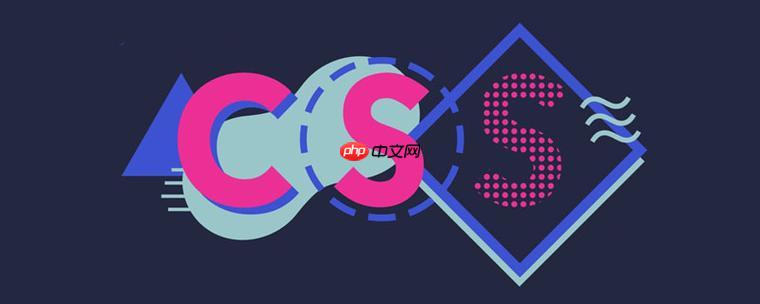实现粘性头部导航最直接的方式是使用position: sticky;1. 设置position: sticky并配合top: 0使元素滚动到视口顶部时固定;2. 确保父元素无overflow: hidden/scroll/auto避免sticky失效;3. 指定top、left等偏移量触发粘性行为;4. 通过javascript添加滚动状态类实现样式过渡;5. 结合媒体查询优化响应式体验;6. 保证可访问性与性能,最终实现既保持文档流又具备固定效果的优雅导航。

在CSS中,实现粘性头部导航最直接、最优雅的方式就是使用
position: sticky
position: fixed
要让一个头部导航具备粘性,你需要在其CSS中设置
position: sticky
top: 0
比如,我们有这样的HTML结构:
立即学习“前端免费学习笔记(深入)”;
<header class="main-header">
<nav>
<a href="#home">首页</a>
<a href="#about">关于我们</a>
<a href="#services">服务</a>
<a href="#contact">联系</a>
</nav>
</header>
<main>
<section style="height: 800px; background-color: #f0f0f0;">
<h2>内容区域1</h2>
<p>这里有很多内容,用于模拟页面滚动。</p>
</section>
<section style="height: 800px; background-color: #e0e0e0;">
<h2>内容区域2</h2>
<p>继续滚动,看看导航栏的表现。</p>
</section>
</main>对应的CSS可以这样写:
.main-header {
position: sticky; /* 关键属性 */
top: 0; /* 当元素顶部触及视口顶部时固定 */
background-color: #333;
color: white;
padding: 15px 20px;
z-index: 1000; /* 确保导航栏在其他内容之上 */
box-shadow: 0 2px 5px rgba(0,0,0,0.2);
width: 100%; /* 确保宽度正确 */
}
.main-header nav {
display: flex;
justify-content: center;
gap: 20px;
}
.main-header nav a {
color: white;
text-decoration: none;
padding: 5px 10px;
transition: background-color 0.3s ease;
}
.main-header nav a:hover {
background-color: #555;
border-radius: 4px;
}
/* 确保页面有足够内容可以滚动 */
body {
margin: 0;
font-family: Arial, sans-serif;
}这段代码的精髓在于
position: sticky; top: 0;
.main-header
.main-header
body
sticky
position: sticky
fixed
absolute
这其实是个很经典的场景选择问题。在过去,要实现粘性头部,我们可能得依赖JavaScript监听滚动事件,动态添加或移除
position: fixed
position: sticky
position: fixed
top: 0; left: 0;
body
padding-top
margin-top
而
position: absolute
body
fixed
fixed
position: sticky
relative
fixed
position: relative
position: fixed
position: sticky
有时候,你按照上面说的做了,结果发现
position: sticky
sticky
第一个,也是最常见的陷阱,是父元素的
overflow
sticky
body
html
overflow: hidden
overflow: scroll
overflow: auto
sticky
sticky
sticky
sticky
举个例子:
<div class="wrapper" style="height: 300px; overflow-y: scroll;">
<header class="main-header" style="position: sticky; top: 0;">...</header>
<div style="height: 1000px;">大量内容</div>
</div>在这种情况下,你的
main-header
.wrapper
.wrapper
.wrapper
header
overflow
sticky
第二个陷阱,是父元素的高度问题。
sticky
sticky
header
sticky
第三个,也是容易被忽略的,就是你必须指定
top
right
bottom
left
position: sticky
sticky
调试时,我通常会打开浏览器的开发者工具:
sticky
position: sticky
top: 0
overflow: hidden/scroll/auto
sticky
sticky
sticky
这些小细节,往往就是决定
sticky
仅仅让导航栏粘住可能还不够,我们总是希望它看起来更精致,用起来更顺手。粘性导航不仅仅是功能性的,它也是用户体验设计的一部分。
一个很常见的进阶样式是滚动时改变样式。当导航栏从常规状态变为粘性状态时,我们可以给它添加一些视觉上的变化,比如增加一个阴影、改变背景色或者缩小字体大小。这能给用户一个明确的视觉反馈,告诉他们导航栏现在处于固定状态。虽然
position: sticky
scroll
body
header
// 简单示例,实际项目中可能需要节流
window.addEventListener('scroll', () => {
const header = document.querySelector('.main-header');
if (window.scrollY > 50) { // 滚动超过50px时
header.classList.add('scrolled');
} else {
header.classList.remove('scrolled');
}
});.main-header {
/* ... 之前的样式 ... */
transition: background-color 0.3s ease, box-shadow 0.3s ease, padding 0.3s ease; /* 添加过渡效果 */
}
.main-header.scrolled {
background-color: rgba(0, 0, 0, 0.8); /* 滚动后变深色透明 */
box-shadow: 0 4px 10px rgba(0,0,0,0.3); /* 增加阴影 */
padding: 10px 20px; /* 稍微缩小高度 */
}响应式设计也是必须考虑的。在小屏幕设备上,一个占据屏幕顶部太多空间的粘性导航可能会显得很笨重。你可能需要调整导航栏的
padding
font-size
可访问性(Accessibility)方面,虽然
sticky
<nav>
<ul>
<li>
<a>
<div>
aria-haspopup
aria-expanded
最后,性能方面,
position: sticky
总的来说,一个优秀的粘性导航不仅要实现功能,更要融入整体设计,提升用户在不同设备和场景下的浏览体验。
以上就是CSS怎样实现粘性头部导航?sticky定位实战的详细内容,更多请关注php中文网其它相关文章!

每个人都需要一台速度更快、更稳定的 PC。随着时间的推移,垃圾文件、旧注册表数据和不必要的后台进程会占用资源并降低性能。幸运的是,许多工具可以让 Windows 保持平稳运行。

Copyright 2014-2025 https://www.php.cn/ All Rights Reserved | php.cn | 湘ICP备2023035733号